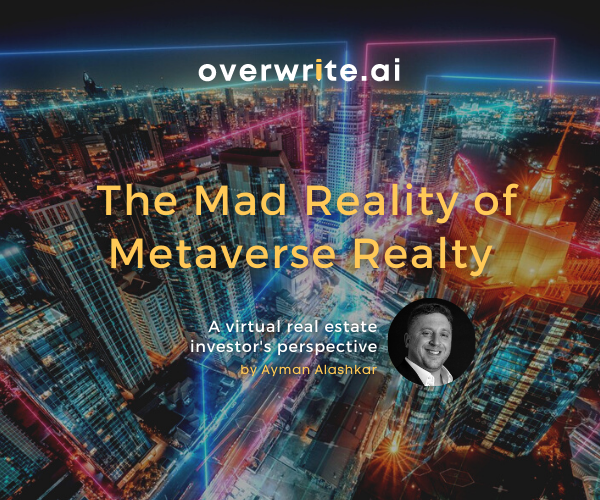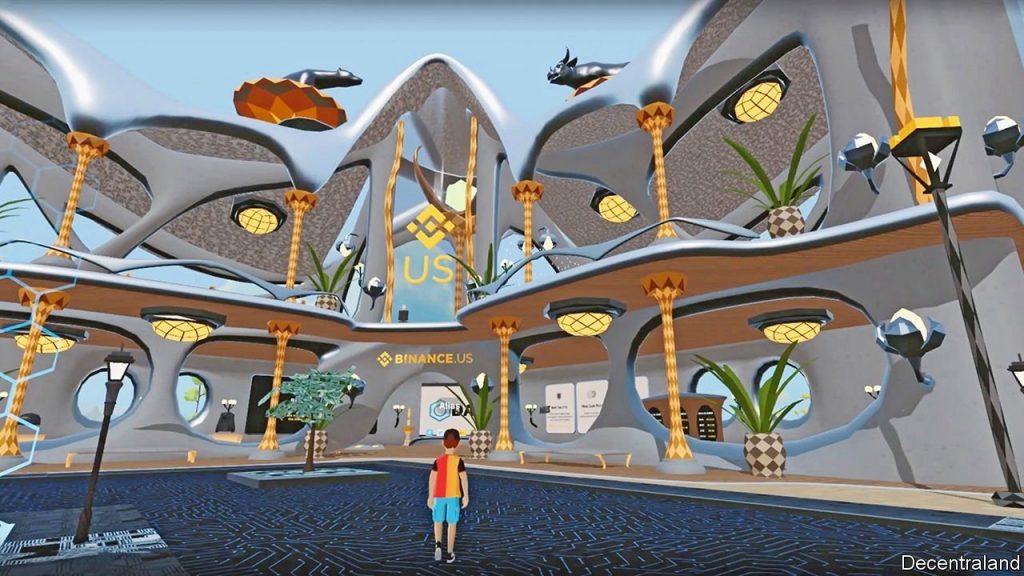
I’ve been busy buying real estate. One day back in mid-December, I acquired four prime residential downtown Manhattan plots of land. Since then I’ve made two unsuccessful bids to acquire an adjoining fifth plot. Together they would complete a super-prime land parcel.
My plan is to merge them and develop a sensational residential block of flats. The plots form part of my balanced, income generating portfolio that now includes the 30-Storey Hyatt hotel in New York’s swanky Chelsea district.
But none of them are real. God above knows I can’t afford that. No. These are virtual world assets. Metaverse properties that mirror their real world equivalents.
The world’s going virtual, and real estate marks no exception.
Tipping The Scales
Virtual real estate ownership is taking off in a big way. The unbridled scale of what’s theoretically achievable in a virtual world, compared to its real world equivalent, is pulling in investors from all corners of the globe.
Increasingly, crypto enthusiasts and property investors like myself are buying virtual property as a speculative investment. Blockchain backed transactions offer some degree of security, in that asset ownership is not simply guaranteed by the metaverse’s developers, rather by a transparent and democratised ledger of records.
In late 2021 a piece of virtual land in a metaverse called Decentraland, was bought for US $2.4million. The land is in the “Fashion Street” area of Decentraland’s map, and the buyer, a subsidiary of Tokens.com, said it would be used to host digital fashion events and sell virtual clothing for avatars.

Just last week ONE Sotheby’s International Realty announced they are selling the first real-world home through a Metaverse called The Sandbox, a community-driven platform that’s one of many emerging Metaverse playing fields. The buyer of the 11,000 sq.ft home in Miami, will also acquire the equivalent virtual real estate of the real world asset. I’m betting the sale will be watched more closely for the practical advantages of owning the virtual version of your real home.
Risking the Hype
Virtual real estate is an emerging space, but it’s heating up fast!
The four leading virtual land platforms —The Sandbox, Decentraland, CryptoVoxels, and Somnium Space —reportedly sold $100 million worth of virtual land in their respective NFTs, in one week. Of that group, The Sandbox made the biggest bucks, generating a massive $86.5 million.
Not one to shy away from an opportunity to promote himself, everybody’s favourite grandad-rapper Snoop Dogg, is developing his own digital community in The Sandbox. And some (in my humble opinion, mad) investor, has dropped $450,000 to buy the virtual home next door to his.

Keep It Simple, Stupid
It goes without saying that investing into Metaverse real estate isn’t for the faint hearted. It’s such a bleeding edge asset class that there are no rules to guarantee success of any kind.
What to buy? Why to buy it? Which Metaverse to invest in? Where in that Metaverse to buy? How much to buy for? What will it be worth? Why will it be worth that? What can be done to derive income or create value with it? And when to stop buying? The list of risks is mind-boggling.
Most importantly…how the heck is asset value defined? I had to consider all these questions when I began my virtual real estate journey months ago. Here’s where I landed.
Rather than allowing myself to be taken down dangerous rabbit-holes, I simplified my investment rationale. I looked for a metaverse that followed basic real world, real estate principles.
Forget Location, Location, Location
Most people will tell you that the first rule of property is Location, Location, Location. They’re amateurs.
Scarcity is the golden rule of real estate. Simple demand and supply. The value of a property’s location is derived directly from the demand for a property and its corresponding supply. Location, and utility (ie what the property can be used for), are both factors therein.
Many of the Metaverses offering real estate ownership do not follow this golden rule. Their virtual boundaries can be pushed back at anytime by their developers, creating fresh supply quite literally overnight. Decentraland’s Fashion Street could easily cease to be fashionable in six months’ time, if more supply gives rise to a strip of land that becomes haute couture’s new epicentre.
How To Invest in Virtual Property?
There’s no single answer. I have a personal interest in the conceptual and actual success of metaverse real estate investment. If you have specific questions I’d be happy to address them in the comments below this article.
I will say this. You already have your own disciplines when it comes to real world real estate investment. My advice, if you’re going to invest in Metaverse property you can get creative, but don’t ignore your fundamental disciplines.
An AI Implementation Strategist accredited by the prestigious MIT in Cambridge, Massachusetts, Ayman Alashkar also has a Bachelors Degree in Mathematics from the world-renowned Queen Mary College, University of London, and a Masters in Real Estate Investment and Development from the University of Reading (UK). With 20 years’ experience working in real estate, banking and artificial intelligence, Ayman is the founder and CEO of PropTech platform overwrite.ai.
overwrite.ai is an AI-assisted content creator that helps real estate agents instantly curate unique and search-optimised property marketing descriptions.
For informative and light-hearted news and views on the world of real estate, follow overwrite.ai on Instagram and LinkedIn, and keep up-to-date with our weekly NewsBites blog.
One thought on “The Mad Reality of Metaverse Realty”